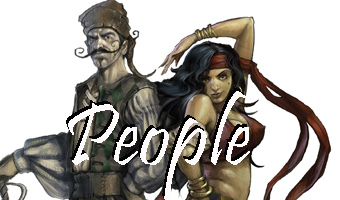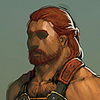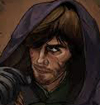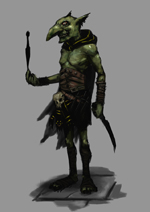The surviving First-men were not seen kindly upon by their vindictive thralls and were subject to a bloody persecution which almost brought them to the brink of extinction. The few who remained took refuge in the wilds and were not heard of for several centuries.
As the new masters of Valorum seized their prize and surveyed the immediate surroundings, they soon derived that the once fertile and bountiful lands encircling the city had been buried under thick layers of cinder and sulphurous ashes. As an obvious result agriculture could no longer sustain more than a miniscule amount of the hungry mouths inhabiting the desolate city. This was the start of an exodus of epic proportions that bereft the city of nearly all its populace. Only the old, weak and infirm lingered, sheltering in the scarce buildings still erect. An antediluvian era of wealth and glory had come to a sudden and violent end.
Several decades later nomadic tribes travelling the barren wastes clenched between the jagged Copper Hills and the Emerald Sea began using the ruins as rudimentary caravanserai. Here they could replenish their water-supplies in unspoiled wells fed by the swift and cool Grey River as they bought dried fish from the locals.
In the absence of good soil the survivors of Valorum now worked the sea in rickety boats and as trade with passers-by made a slow but steady increase, they eventually rose from squalor to a somewhat more dignified existence.
Trade had made its first impact on what was to become Köping and its effects would continue to influence the city in ages to come as it turned out that Köping´s location dominating the mouth of Grey River made it the perfect port for trading with the Inland Kingdoms. The kingdoms were in truth fortified cities with just enough military prowesses to enforce their rule upon the villages and farms in their immediate vicinity.
Most of the Inland Kingdoms clung to the foothills of the great mountain ranges beyond the Copper Hills, and were thus in great abundance of ore, minerals and costly pelts. All these goods were in great demand across the Emerald Sea, where the Dwarves and the Ahuramaz Empire seemed to have a never ending craving for such commodities. Seeing no good reason to deny them, the merchants of Köping bought cheap and sold costly, thereby maximizing the use of their advantageous position as middle hand.
This led to that Köping half a century later, began to cement its hold on local trade as the small community developed into a prospering city. Still minor but with obvious ambitions of continuous growth. Although still dependant on and fishing for sustenance, Köping was by now guarded by a sturdy fort, built to ward off corsairs and pirates, thereby securing vital trade routes. The city was at this point led and controlled by a sovereign conglomerate of mighty merchants naming them selves The Ruling Five. Being close to omnipotent oligarchs the Ruling Five laid out the new course for Köping´s future which according to them incorporated aggressive trade, more often than not backed up by hired swords, a society full of nepotism and bribes and inhabitants distanced from the ruling elite.
That Köping´s newly built fleet began to sack and burn competing maritime cities might have had a certain influence on its sudden rise in influence.
As years passed the fields and pastures circumnavigating the city regained some of their former growth power, although never again yielding the same rich harvests as before the cataclysm. This however made further expansion of Köping a real possibility as it now could house even more citizens, which it soon did. As the lucrative trade, low morals and notoriously low taxes were quite appealing to most; Köping was soon recognized as a veritable melting pot of races, cultures, occupations, fortune seekers and private interests.
Now was also the time when the First-men made their re-entry into the city. Albeit scorned and frowned upon by the average man, they silently became a part of society. More often than not they took up residence in the uninhabited areas consisting of old derelict Valusian ruins and rubble. Here the First-men laid the corner-stone to what was to become Old Town, built in weathered but sturdy stone, but covered in lichen and with a perpetual shimmer of grandeur gone-by. Old Town would however prove to withstand the test of time, while most parts of Köping would not, as continuous outbreaks of fire would constantly re-shape the city’s appearance in the future.
Some time later Köping would encounter its first real setback as the neighbouring city-states grew tired of being exposed to unfair competition and monopolistic trade ethics. When they simultaneously spotted easy pray and a god-sent opportunity to pillage an outnumbered adversary things escalated out of hand. This was the beginnings of the Ninefold Wars; named so by the number of city-states participating.
Alas! Köping stood alone and after a series of minor and indecisive skirmishes, the Ruling Five of Köping were forced to meet the enemy head-on to protect the city from being ransacked. After suffering a crippling defeat on Brimstone Plain, the oligarchs had to strike colours outside their own city walls. In doing this the city was spared by its foes but instead forced to pay an enormous sum consisting of gold and valuables, forfeit close to all of its lands and finally restrict their merchant fleet to a fixed number of vessels. As a secondary effect, the Ruling Five were disposed of by their captors in a bloody and accustomly agonizing way, and the city’s reigns were hence shifted into the hands of a morally versatile Burger-Rat elected by the victors.
The Gods seem to have lifted their hand from Köping and it was not until a Hero entered the scene that things started to improve. Szymond Edelstahl was one of Köping´s now hobbled merchants, who in contrast to the others refused to give in and fully accept Köping´s fall from grace.
By revitalizing the banking industry and at the same time convincing and uniting the merchant guild into selling options on future shipments and profits, he raised the funds to employ an army of somewhat negotiable loyalty. With a single strike, taking the enemy unaware, Szymond and his rag-tag army managed to regain both land and privileges formerly belonging to Köping, Szymond becoming a city legend in the process. The bloody aftermath however led to a century of hap hazardous war between all the near by city-states and the effects reverberate to this day since the mistrust and animosity between the cities still remain to various degrees.
And so something new rose from the old as the quislings in the Burger Rat all met brutal but expected ends and Köping´s government was passed to Szymond Edelstahl who willingly accepted the role as Supreme Chancellor.
In his illuminated, but all too short reign, Szymond founded the Sun-Mountain Academy to further education and provide each citizen with the opportunity to elevate themselves through the social hierarchy. He initiated the monumental project of constructing a functional and proportionate sewer system for Köping, creating employment for the poor and improving the health and sanitation of the masses. He ordered the building of at least three of the Köping´s great bridges since the city now encompassed both shores of the Grey River.
To finance all of this Szymond sadly enough committed a crime so heinous that the noble Lords and influential guildsmen could never forgive him despite his great service to the city; he raised the taxes.
In doing so he also signed his own death sentence. After only a six year rule Szymond one day tragically slipped on a bathroom mat while peeling an orange, accidentally stabbed himself in his left eye with the fruit-knife and fell haplessly into the bathtub where he seemed to have misplaced his pet electric eels. A curious rumour that his death was the handicraft of the sly and cunning Ogres of Köping led to a rampant but short pogrom that decimated the Ogre population severely in a matter of days. Things however settled shortly thereafter as a concluded in-depth investigation stated that the death of the Supreme Chancellor was a freak accident and no-one accountable.
The masses mourned Szymond deeply and his remains still lie resting in his magnificent tomb on Solemn Isle.
Since no power-fraction now seemed to fully trust the other, the city rule was divided into a triumvirate representing the nobles, merchant guild and academics/wizards/artisans???
It was in this way that Köping during the following three hundred years took its final leap from influential and prominent city to that of a milling metropolis, dominating the sea ways for uncountable nautical miles. As a central hub for all kinds of trade, this including the lucrative buying and selling of slaves, Köping filled it’s coffers with gleaming gold and used it mainly to gain more wealth, hence increasing its monetary muscle even more.
The greatest exception to this is however the constant import of food, as the sprawling city no longer can provide enough measures to sustain itself. Grain barges and ships trafficking wine and fruit are an essential part of Köping today and a disturbance in this business could prove disastrous.
Trade now runs in the veins of most residents in Köping and even the noble houses have branches and enterprises with commerce as focal point. Honour, heritage and pedigree are all good things to have, but it is money that makes things happen. It is this mentality that has drawn members from almost every sentient race on the continent to Köping and it is here that they all seek their fortune as Köping encompasses the best and the worst alike.
In present day Köping´s allure draws people from all corners of the world. Your pot of gold might well be waiting at the end of the rainbow, if you’re deft and strong enough to outsmart or kill the ten other persons reaching for it…
|






























